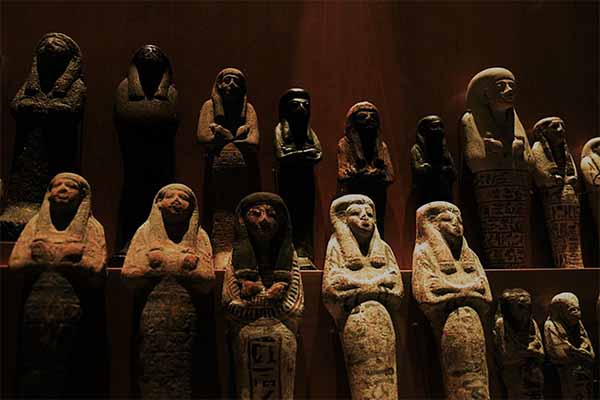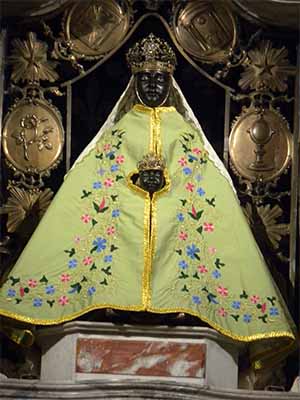Egyptian Gods And Goddesses in Ancient Celtic Mythology ?
How did the Egyptians and the Gauls come to worship the same gods? We still wonder about the paths taken by Isis or Osiris to see their worship celebrated in Arles or Lyon.
Once Gaul was conquered by the Roman legions, it is not surprising to see the victor erect temples dedicated to its gods, protectors of the "Eternal City" and also of the nations it has subjugated. But the Gallo-Romans also worshiped deities from much further afield.
Ushabtis in gallic territories

Archaeological excavations have revealed the success of the Ushabtis, Egyptian funerary statuettes, as well as the bronze funeral Osiris, found in large numbers in the bed of the Saône, from Arles to Lyon, and in the hinterland open to the circulation by Roman roads. Then there are feasts in honor of Egyptian gods: in March, in Marseilles, Arles and in the major river ports, the "Isis Vessel" was celebrated, a feast which marked the opening of navigation. Jars were then offered with the effigy of Isis-Ceres and Serapis-Helios. The celebration of the "Invention of Osiris" in the fall promised bountiful harvests. In the Rhone Valley, terracotta wall medallions confirm that Isiac festivals were popular there. In Haute-Garonne, a gilded bronze head of Serapis-Hélios decorated a villa. In Nîmes, a colony founded by men from Egypt, as recalled by its coins minted with the effigy of the crocodile and the palm tree, a temple was dedicated to Isis.
All roads lead to Rome
At that time, the port of Alexandria, on the Nile Delta, was Greek. Greece is declining, Rome dominates and Gaul is Roman. From a geographical point of view, the paths taken by cultural and religious mediation between the East and Gaul seem obvious: first the seaway, then the major Roman traffic axes, notably the Rhine-Rhône axis. This serves the ports of Marseille and Arles, Nîmes, but also Narbonne and Toulouse, then the north of the Rhône basin, with Lyon. This axis then branches off to the west, towards the Loire and the Allier, with sanctuaries linked to natural sources.
Road nodes, trading towns, Roman garrisons, where many soldiers had served in the East, were also active places of propagation. In the west, navigators from the Atlantic played a more limited role. The Garonne basin, the coasts of the Atlantic and the English Channel seem to have suffered little from Eastern influence.
Isis and Osiris, versatile gods
Isis, Egyptian goddess of Heaven, both sister and wife of Osiris, mother of Horus, is the model of conjugal love and maternal devotion. Osiris, god of the Nile, nourishes the earth, guarantees fertility and ensures the protection of the dead. As such, it imposed itself on all Gallic territory. Isis patronized merchants, navigators as well as soldiers and their staff. No doubt it is thanks to the plurality of their powers that the oriental deities were favorably received in Gaul, as in Vichy or Néris-les-Bains, in Allier, where ex-votos of oriental healing gods were associated with indigenous objects.
Syncretism or new religion?
Generally speaking, the Egyptian gods conquered populations that were more or less Romanized, or else they joined together with local cults by strengthening them. All circles were affected but places of worship were rare, even if Lyon had a chapel dedicated to Isis. Nevertheless, certain liturgical rites have imposed themselves: a new way of praying, an observance of the rite and meditation, the belief in a hereafter after death, which prefigures the theme of the resurrection. From then on, this original religious syncretism, which radically transformed pagan mores, will remain very present in Rome and its Empire, even when a new religion, Christianity, also from the East, appears. In turn, it will have to adapt to local traditions such as the worship of female deities. Is the cult of Mary part of this heritage?

The Black Madonna of Puy-en-Velay
Black virgins have always been a mystery to Christian iconography. Frequent in Provence and Auvergne, they seem to belong as much to the domain of esotericism as to that of religion. The statue which is currently on the high altar of Notre-Dame cathedral dates from the 17th century. Of the original, we only know of reproductions. It is a cedar statue believed to have come from Egypt and allegedly offered by Saint Louis on his return from the 7th Crusade. It would represent an oriental goddess, perhaps Isis, or a Coptic Virgin. She stands in the position of the Romance Virgins in Majesty. But the presence of a Black Madonna in Le Puy is attested as early as the 10th century and would have served as a model for the first Virgins of Auvergne. Does it indicate the survival of an older oriental cult?









































































































































































































































































































































